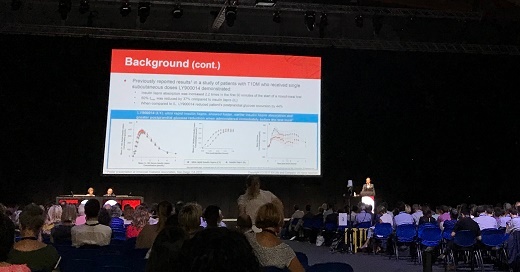The annual meeting of the European Association for the Study of Diabetes (EASD) took place this year in the city of Lisbon. Interesting novelties in the field of type 2 diabetes mellitus (T2DM) and new evidence for the existing medications were presented during the conference, including 3 oral presentations and several posters from Profil.
If you missed EASD this year or could not attend all the presentations you were interested in, here you find a short overview of some of the relevant data presented related to body weight reduction, new substances to treat type 2 diabetes and the effect of T2DM medications on cardiovascular risk outcomes.
We hope you enjoy it.
Aiming for body weight reduction
Achieving an improved long-term glycemic control, as reflected in the HbA1c, does not seem to be the sole objective of the therapy anymore; the interest in accomplishing a greater and sustained weight reduction with the diabetes therapy is increasing due to the high frequency of concomitant overweight and obesity among patients with T2DM. Currently the Glucagon-like Peptide 1 receptor agonists (GLP-1RA) and the Sodium-glucose co-transporter-2 (SGLT2) inhibitors are the most promising drug groups tackling body weight in the treatment of T2DM. The following trials reported benefits on body weight reduction:
DURATION-7 trial
This trial investigated the added benefits of exenatide extended-release (Bydureon, AstraZeneca), a GLP-1RA for subcutaneous administration once weekly, in T2DM patients on basal insulin and not achieving glycemic targets. The trial included 464 patients inadequately controlled with basal insulin +/- metformin. Data showed a mean reduction in HbA1c of 1.0% in subjects receiving exenatide once weekly plus insulin glargine (IG) for 28 weeks in comparison to 0.3% reduction in subjects receiving placebo plus IG. The HbA1c reduction was accompanied by a reduced risk of hypoglycemia. The subjects on exenatide once-weekly lost on average 1.5 kg more than subjects on placebo.
DURATION-8 trial
Exenatide extended-release was also the protagonist of this trial, where it was administered once weekly together with dapagliflozin (Forxiga, AstraZeneca), a SGLT2 inhibitor. The effect of the combination therapy was compared to the effects of the two drugs administered separately. The study had duration of 28 weeks and included 695 subjects with T2DM inadequately controlled with metformin monotherapy. Subjects in the combination group experienced a greater mean reduction of HbA1c after 28 weeks (-1.98%), compared to dapagliflozin (-1.39%) and exenatide (-1.60%) alone. A greater proportion of subjects (44.7%) achieved an HbA1c below 7% in the combination therapy. Another positive effect of the combination therapy was a greater weight reduction at week 28, which was superior in the combination therapy (-3.6% change from baseline) than in dapagliflozin (-2.2%) and exenatide (-1.6%) alone.
SUSTAIN-6 trial
Semaglutide is a once-weekly GLP-1RA under development by Novo Nordisk. In this study 3927 subjects with T2DM were randomised to receive semaglutide s.c. 0.5 mg, 1 mg or placebo. Subjects were observed for 104 weeks. The benefits of semaglutide in the primary endpoint were demonstrated using a composite major adverse cardiac events (MACE) outcome including cardiovascular (CV) death, non-fatal myocardial infarction or non-fatal stroke. In terms of body weight reduction, subjects receiving semaglutide 0.5 mg had a mean weight reduction of 3.6 kg at the end of the treatment while those receiving 1 mg had a mean reduction of 4.9 kg. In the placebo arms the reduction was 0.7 and 0.5 kg. Importantly, a post-hoc analysis demonstrated that the weight reduction experienced by the subjects was not direct result of increased nausea and/or vomiting, which are common adverse events of GLP-1RA.
VERTIS-SU trial
In this trial, ertugliflozin, a novel SGLT2 inhibitor for oral administration, was investigated. Ertugliflozin, developed by MSD and Pfizer, is currently under regulatory review in the US and the EU. A total of 1325 subjects with T2DM were randomised to receive ertugliflozin 15 mg q.d., 5 mg q.d. or treatment with a sulfonylurea as active comparator (glimepiride 6 or 8 mg q.d.) for 104 weeks. The primary endpoint was HbA1c reduction at week 52. Overall, the subjects experienced a mean reduction in HbA1c of 0.6% in ertugliflozin 15 mg and 5 mg compared to a mean reduction of 0.7% in subjects receiving glimepiride. In conclusion, the trial met its primary objective by demonstrating that ertugliflozin 15 mg was not inferior to glimeperide in terms of HbA1c reduction. An important benefit of ertugliflozin was weight reduction, which was -1.3% change from baseline in patients receiving 15 mg and -1% in patients receiving 5 mg. Patients on glimepiride had a mean weight reduction of -0.9% after 52 weeks.

New substances
Several interesting novel substances were presented, including two new takes on GLP-1 receptor activation:
MEDI4166
The company MedImmune presented a novel antibody PCSK9-peptide GLP-1 RA fusion molecule called MEDI4166. This molecule is intended to tackle both glycemic and cholesterol control in subjects with T2DM. The safety of this compound was evaluated in a single-ascending dose study in 40 patients with T2DM. Gastrointestinal effects were the most commonly reported adverse events, but there was a similar distribution of these effects in the verum and placebo groups. The development process of this drug continues since no safety concern arose during this trial.
TTP273
The company vTv therapeutics presented an oral, non-peptidic, GLP-1 RA. Safety and efficacy were evaluated in a study with 174 patients with T2DM. Different doses were tested and demonstrated to be superior than placebo in reduction of HbA1c, FPG, systolic BP and weight. Interestingly, less nausea was observed in subjects receiving active than in those receiving placebo.
Cardiovascular risk
A great deal of attention has been given to the effect of the medications for T2DM on CV outcomes. This is motivated by the excess of CV morbidity and mortality in patients with T2DM. These CV outcome trials received most attention at EASD:
ACE trial
This study was completed in April 2017 and included 6526 patients of Asian origin with coronary artery disease and impaired glucose tolerance (defined as fasting plasma glucose > 126 mg/dl and 2-hour plasma glucose ≥140 mg/dl and < 200 mg/dl). Participants were randomised to receive oral acarbose 50 mg or placebo t.i.d. The primary endpoint was a 5-point MACE composite outcome including CV death, non-fatal myocardial infarction, non-fatal stroke, hospitalisation for unstable angina and hospitalisation for heart failure. The median follow-up was 5 years. The results did not demonstrate superiority for the primary endpoint (HR 0.98, 95% CI, 0.86 – 1.11), although subjects on acarbose exhibited a significant 18% reduction in the incidence of new-onset diabetes.
EXSCEL trial
This trial involved more than 14000 patients with T2DM at a wide range of CV risk, from 35 countries, and randomised them to once-weekly exenatide (2 mg subcutaneously) or placebo on top of usual care. The observation period was in average 3.2 years. The trial met its primary endpoint, which was non-inferiority in a 3-point MACE outcome including CV death, non-fatal myocardial infarction and non-fatal stroke (HR 0.91, 95% CI, 0.83 - 1.00) However, exenatide was not superior to placebo in the CV outcomes, which was also a pre-specified primary endpoint. Interestingly, subjects on exenatide had a significantly lower all-cause mortality than the placebo group, HR 0.86 (95% CI, 0.77 – 0.97).
CANVAS trial
This trial included 10142 patients with T2DM at CV risk, and evaluated the efficacy of canagliflozin 100 and 300 mg q.d. against placebo. The primary endpoint was a 3-point MACE composite outcome including CV death, non-fatal myocardial infarction and non-fatal stroke. The mean follow up was 188 weeks. At the end of the observation period subjects on canagliflozin exhibited a mean reduction of 0.58 % in HbA1c. Subjects on canagliflozin had significantly less CV events as defined by the 3-MACE outcome with a HR of 0.86 (95% CI, 0.75 – 0.97) and significantly less hospitalisation for heart failure (HR 0.67, 95% CI, 0.52 – 0.87). However, all-cause mortality was not significantly different in subject on placebo or canagliflozin (HR 0.87, 95% CI, 0.74 - 1.01). As expected, most adverse events reported with canagliflozin were genital infections (more frequently mycotic infections in female participants) and increased osmotic diuresis. On the other hand, risk of amputation was also higher in the group of canagliflozin.
Coming next
Next week we will provide you with a small synopsis of our oral presentations about the effect of food intake on the absorption of oral basal insulin, the efficacy and safety of oral insulin and the improvement in postprandial glucose excursions of a novel formulation of insulin lispro.




